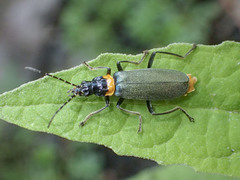Body flat with yellow-orange stripe behind the head (around back of pronotum). Wings cases (elytra) dark green, covering a yellow-orange abdomen. Head and legs black. Plague Soldier Beetles form huge swarms of mating beetles in late summer. They visit flowers and are thought to feed on nectar, pollen and soft-bodied invertebrates. Their larvae live in the soil and eat soft-bodied invertebrates.
The soldier beetle also secretes the same chemical in a wax form to protect it’s eggs against infection.
Researchers have recently found the genes that give the chemical its anti-microbial and anti-cancer properties, and were able to replicate the synthesis in the lab. This may one day lead to the development of new anti-biotic and anti-cancer related products.
You can help suppport me bringing this information to you via my Paypal
What habitats does Chauliognathus lugubris live in?
Woodlands, dry sclerophyll forests and gardens
What is the distribution of Chauliognathus lugubris?
South-eastern mainland Australia and Tasmania
How big does Chauliognathus lugubris grow?
Body up to 2 cm long
You can support me by dropping some funds into my Paypal account
This does not mean that it cannot be found locally, just that I have not been able to verify records at the time this species was added to the database.
Disclaimer: A lot of work goes into trying to identify and ensure accurate identifications are made and that the listed Descriptions, Sizes, Habitats and Distribution information is as accurate and valid as possible. Unfortunately, information in this arena is ever changing and as such no guarantee can be offered that it is correct or currently valid as a result the information is provided as a guide, and it is always suggested that you do a little research to ensure you have the latest and most accurate information. View the reference's or bibliography I welcome any feedback and comments on the information provided.

